
Sai Nrityotsava
4
- Mysore B
Nagaraj, Bangalore
e-mail: articulateindia@gmail.com
September
5, 2009
Organizations
that provide platforms to well established dancers, abound. Only countable
few give opportunities for the newbies. Sai Arts International, Bangalore,
is one among them. However, it does take care to ensure that artistes that
are to be presented have achieved certain degree of proficiency and are
worthy of hosting, even if it be child dancers. On 1st September 2009 at
Seva Sadan, Bangalore, the 4th Sai Nrithyotsava did just that. Beginning
with this series, it ventured to invite dancers from as far as Bengal.
The prekashaka was catered to five segments in three styles of Indian classical
dances, Mohiniattam, Bharatanatyam and Kathak.
Vini Gautam,
Urmimala Maitra and Nisha Mariam Mammen, disciples of Guru Swapna Rajendra
Kumar, of Nrutyangan school of dance, Bangalore, performed Mohiniattam.
The opening number was a prayer to Lord Ganapathy, set in Ragam Atana and
to Adi Talam. The Sahithya chosen to carry this obeisance to the Lord was
interestingly different and weaned away from a full course of bhakthi.
Lyricist Kavalam Narayana Paniker visualizes the elephant headed, big bellied,
large eared lord, mistake Ganga gushing from His father's locks as warm
milk and drinks it. A vikata that he was, Bala Ganapathy roasts the rice
grains in the heat of Shiva's fire from his third eye; the white flowers
on Shiva's shoulders feels like puffed rice and he tries to make Appams
out of the ash that lies at Shiva's feet, only to be tenderly chastised.
The sway of the elephant's trunk, the swish of its ears and the gait became
the grammar of their movements fully justifying the dance of the enchantress
- Mohiniattam. The trio chose to describe the beauty of Krishna through
the composition "Shri Krishna Karnamrutham." The dance numbers were Dr.
Kanaka Rele's choreography.
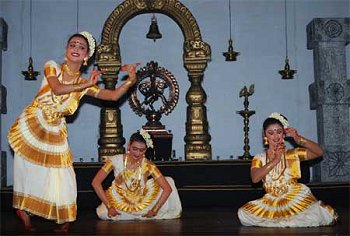 Disciples
of Swapna Rajendra Kumar
Disciples
of Swapna Rajendra Kumar
|
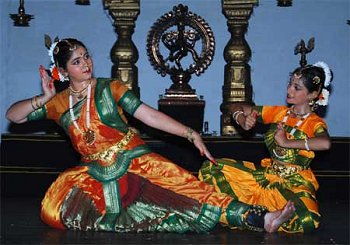 Disciples
of Suparna Venkatesh
Disciples
of Suparna Venkatesh
|
Suparna Venkatesh
presented her young disciples in Bharatanatyam. Pooja, Riya, Anjana, Deepika,
Mahima, Ananya, Shweta, Shruti and Brinda gave an almost seamless presentation
of a Pushpanjali, Ganesha Kauthwam, two Alarippu, two Keerthana and a Jathiswara.
The nimble footed nine conveniently divided the repertoire between themselves,
and filled the recital with verve and energy that seemed never to stop.
Choosing one composition on Hara and another on Hari in the Keerthana was
a good concept that united the two streams of Hinduism. Suparna's choreography
and training was justified by the little angels.
Vineet Kumar
Nigam and Sunayna S Punjabi, disciples of Guru Dr. Maya Rao, presented
Kathak. They began with a composition that opened with Goswamy Tulasidas's
Shiva Stuti, meandered through two selected verses from Adi Shankaracharya's
'Vedasara Shiva Sthava' and concluded with a brisk poetry of Balwant Rai
Bhat that was set to rhythm. A vibrant 'Kavith' from Banaras Gharana at
the end of the number depicted the Lord's cosmic dance. The duo next rendered
pure nritta to the refrains in Raag Khambavathi. The rendition of Tath,
Amadh, Tukdas and Parans in Teen Taal was brisk, crisp and elegant and
drew applause. Instead of the usual signature piece of Tarana, Vineeth
and Sunayana surprised the audience with a 'Triwat' that is rarely performed
of late by the Kathaks. Thanks to Guru Maya Rao for preserving such beautiful
compositions like Prabandh, Lakshannrutya and the one the young dancers
performed with agility and dexterity.
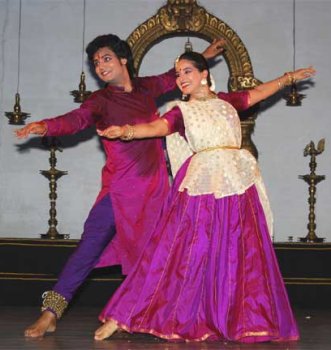 Vineet
and Sunayna
Vineet
and Sunayna
|
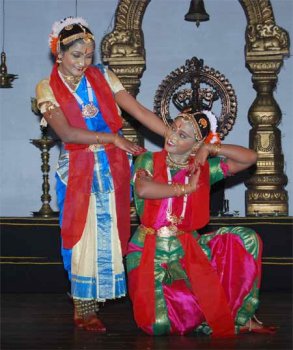 Madhuri
Sarkar and Koushiki Saha
Madhuri
Sarkar and Koushiki Saha
|
Bharatanatyam
from the shores of Bay of Bengal at Tamilnadu danced its way eastwards
to the mouth of Ganges in Sonar Bangla. But three East Indian damsels
moved southwards to Bengaluru to share their acumen of the South Indian
classical dance.
Madhuri Sarkar
and Koushiki Saha, shishyas of Guru Sarbani Ghosh Chatterjee of Kolkata,
performed the perfunctionary Pushpanjali. The Talapushpaputa Karna in this
Rangamancha was danced with ease and perfection. The Sanskrit composition
"Manikyaveena" was done with grace and restrain bringing out the beatitude
of the Mother Goddess, a concept that has come from time that is even pre-Vedic.
It was Dr. Yamini Krishnamurthy's experiment to emote to Rabindranath Tagore's
poetry in Bharatanatyam that inspired Sarbani Ghosh to render Gurudev's
song through Madhuri and Koushiki. The song meant "Oh the Night has passed."
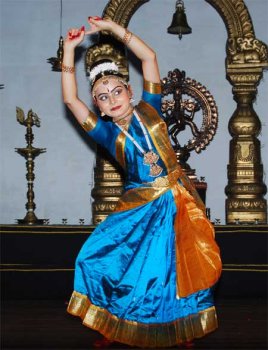 Arpitha
Saha
Arpitha
Saha
|
Arpitha Saha,
disciple of Guru Khagendranath Burman, Kolkata, performed three abhinaya
dominated compositions after her invocation to Ganesh. Pretty and petite,
Arpita glorified the deeds of Gopala Krishna in the Bhimpalasi Keertana
"Gokula Nilaya" and through her dance canvas painted the various moods
of Radha, ranging from excitement to sadness, from jealousy to adoration
in her rendition of Jayadeva's composition culled from Geeta Govinda. The
Swadheenabhartrika Nayika was beautifully expressed in the Javali, demanding
of her Nayaka to come and embrace her and never ever to leave her. The
Thillana in Vasantha Raga was performed with beautiful geometrical moves
across the stage to a sahithya that was in Hindi.
Dance has no
geographical or linguistic barriers. The girls from the Land of Tapothi
River won appreciation from the purists of the Cauvery basin.
Kathak dancer Mysore B Nagraj
is the Artistic Director of Articulate, that promotes performing arts,
takes social responsibility of the visually challenged through the medium
of dance. |

